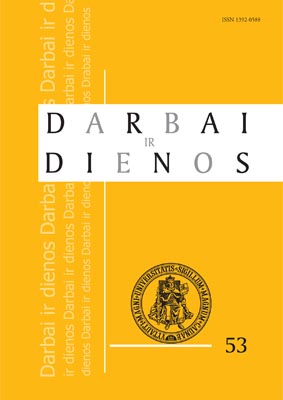Šv. Marijos Magdalenos de’Pazzi kultas Lietuvos baroko kultūroje: atvaizdai ir istorinė tikrovė
The Cult of Saint Mary Magdalene de’Pazzi in the Baroque Culture of Lithuania: Images and Historical Reality
Author(s): Aušra BaniulytėSubject(s): Cultural Essay, Political Essay, Societal Essay
Published by: Vytauto Didžiojo Universitetas
Keywords: kultas; kontreformacija; Baltijos regionas; cult; Counter-Reformation; Baltic region
Summary/Abstract: Remiantis ikonografiniu paveldu, įvairiais XVII–XVIII a. tekstais ir analizuodami iki šiol mažai tyrinėtą Lietuvos istoriografijoje šventųjų adoravimo socialinį kontekstą straipsnyje atskleidžiamos Šv. Marijos Magdalenos de’Pazzi kulto įvairialypės bei daugiasluoksnes prasmes: sakralinę ir politinę reikšmę XVII a. antrosios pusės Lietuvos baroko kultūroje ir Bažnyčios istorijoje. Be to, straipsnyje nagrinėsime kaip šventųjų – religinių tiesų skleidėjų – garbinimas veikė skirtingų Europos regionų bendravimą, akcentuojantį diplomatinius santykius tarp didikų dvarų ir kartu intelektualinių vertybių sklaidą bei jų poveikį politinei raidai, neatsiejamai nuo krikščionybės istorijos konteksto. The veneration of St. Mary Magdalene de’Pazzi (1566–1607, canonized on April 28, 1669 in Rome by Pope Clement X Altieri) was characteristic of Carmelite monasteries and extensively diffused in Baroque culture. Her cult best illustrates the images representing the saint and her visions, which were typical not only for the Italian painters of the 17th century, but also wide-spread in other European countries. The main aspect of the cult of St. Mary Magdalene de’Pazzi in Lithuania was connected with the spread of the ideas of the Counter-Reformation in Poland-Lithuania as well as with the political activities of the Pacas family and the Pontificate’s interests in the Baltic region.
Journal: Darbai ir dienos
- Issue Year: 2010
- Issue No: 53
- Page Range: 225-258
- Page Count: 34
- Language: Lithuanian

